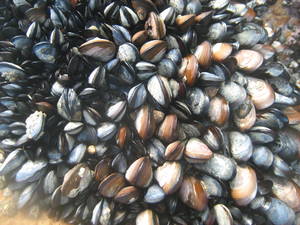Mussels solve sticky problem
Interview with
Mussels are particularly delicious in a seafood paella. But the problem in getting them onto your plate is that you have to first peel them off the rocks and break them open - which can be a challenge. This is because mussels use their powerful foot to cling to surfaces, sticking like glue both in and out of water. Now, researchers have made a biologically-inspired glue, using mussel foot proteins, to create a super-strong substance that could be used in a number of useful ways, from repairing ships to sealing up human surgical wounds. Amelia Perry spoke to Timothy Lu, who led the work...
onto your plate is that you have to first peel them off the rocks and break them open - which can be a challenge. This is because mussels use their powerful foot to cling to surfaces, sticking like glue both in and out of water. Now, researchers have made a biologically-inspired glue, using mussel foot proteins, to create a super-strong substance that could be used in a number of useful ways, from repairing ships to sealing up human surgical wounds. Amelia Perry spoke to Timothy Lu, who led the work...
Timothy - Well, mussels have this really impressive ability to stick to surfaces underwater, and so we've been inspired to do is to use the tools of synthetic biology to see if we can take those proteins and try to put them into an artificial system to make them better. So, what we did was to actually combine the adhesive properties of mussels with the adhesive properties of bacteria. What we've done is to fuse those mussel foot protein genes with genes in E. coli that encode the production of what's known as curli fibres. Curli fibres are these extracellular fibres that bacteria make and they're self-assembling fibres, and so, what we've done now is to make these curli fibers fuse with the mussel foot proteins such that we have a big jumble of these fibres on the outside of the bacteria that display these mussel foot proteins, thus allowing us to get very strong adhesion to surfaces.
Amelia - So you inserted genes from the mussels, put them into E. coli, and essentially used them as mini bacterial factories in order to produce this glue. How did you go about extracting it?
Timothy - That's right. So, we took the DNA from the mussels, we can combine it with the DNA that encodes the curli fibres from E. coli and then we insert that hybrid set genes into bacteria and have them be factories to make a lot of these sticky, curli proteins. Now, the interesting thing is when you do this, the bacteria essentially make tons and tons of these fibres and what you can do is extract fibres from the bacteria, either by cracking the cells open and pulling out those proteins, and then what we do is purify those proteins, and then assemble the fibres in a test tube.
Amelia - Are you producing enough of this glue for an industrial scale here, or is this still very small steps at the moment?
Timothy - We've primarily focused on small-scale production because we wanted to first verify that the materials have the desired properties. That being said, because we are making these glues in bacteria and there are a lot of well validated industrial processes for making proteins out of bacteria - we believe we can scale this up into much larger settings to make practical scale materials. There are a lot of potential applications. One obviously, is to use the glues for underwater repair of ships and other underwater materials. Another possible application is actually use this glue in patients where you often want to adhere different pieces of tissue together in wet conditions in the body during surgery or other medical operations. Finding good underwater glues that can stick surfaces together and maintain that adhesive nature is a challenge so we think that with further development, these types of glues may also be useful for human applications.
Kat - Timothy Lu at the Massachusetts Institute of Technology and they published that work this week in Nature Nanotechnology.
- Previous Astrobiology: What's the point?
- Next Big Bang dustup










Comments
Add a comment